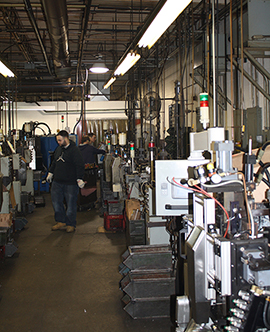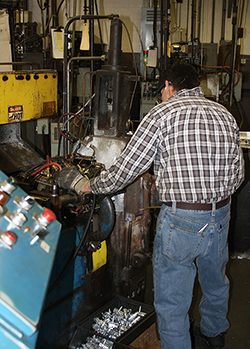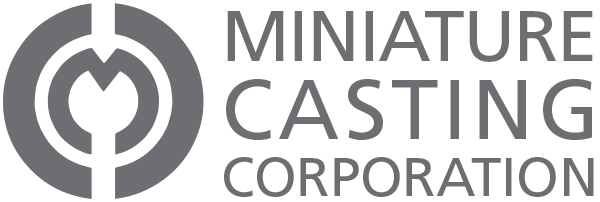Zinc casting alloys enable the product engineer and designer to produce components using a wide range of casting processes and to supply quantities ranging from one to millions of pieces per year. In fact, zinc alloys surpass all other ferrous and nonferrous alloys in casting-process flexibility.
Die Casting
The vast majority of zinc alloy castings are produced by pressure die casting. The Zamak alloys and ZA-8 are cast in hot-chamber die cast machines. The hot-chamber process uses a metal pump immersed in a molten zinc bath. Metal is pumped from the bath through a nozzle and into the die. After solidification, the die opens, ejecting the finished part. Hot-chamber die casting produces castings with intricate detail and excellent surface finishes at extremely high production rates. Cycle times of 350-450 shots-per-hour for larger parts are common.
 Extremely small castings (i.e., up to a few ounces) are produced on special hot-chamber machines with very high cycle times (approx. 900 shots-per-hour). These machines are capable of producing flash-free, zero-draft, very close-tolerance castings that require no secondary trimming or machining operations. One type of miniature die casting machine is the four-slide machine. This machine uses four sliding dies to produce highly complex and tight-tolerance components.
Extremely small castings (i.e., up to a few ounces) are produced on special hot-chamber machines with very high cycle times (approx. 900 shots-per-hour). These machines are capable of producing flash-free, zero-draft, very close-tolerance castings that require no secondary trimming or machining operations. One type of miniature die casting machine is the four-slide machine. This machine uses four sliding dies to produce highly complex and tight-tolerance components.
Die Cast Alloy Selection
Zinc alloys fall into two groups. The first group includes the traditional Zamak alloys, Nos. 2, 3, 5 and 7. All contain nominally 4 percent aluminum and a small amount of magnesium. (Magnesium is added to improve strength and hardness and to protect castings from intergranular corrosion).
Alloys 2 and 5 also contain copper, which further strengthens and improves wear resistance of castings but at the expense of stability (dimensional and property), especially when copper content exceeds 1 percent.
The No. 7 alloy is a special high-purity alloy, which may be specified for die castings requiring optimum surface finish (i.e., decorative applications). The high purity and small nickel addition permit the magnesium content to be lowered for maximum fluidity and ductility.
This group of zinc alloys is predominantly pressure diencast, with No. 3 being the most widely used alloy in North America. It offers the best combination of mechanical properties, castability and economics. Other alloys, being slightly more expensive, are used only where their specific properties are required.
In addition to the Zamak alloys, ZA-8 alloy can also be hot-chamber die cast. ZA-8 is a high-strength alloy containing a nominal eight percent aluminum. The alloy also contains copper and magnesium for optimum castability and mechanical properties.
Typical Properties Profile of Zinc Casting Materials
Zinc alloys are not suited for heavy continuous stresses or high temperature service in the broad engineering sense, but perform well under conditions of moderate continuous loading and of high short-term or impulse load. Their thermal and electrical conductivity properties are favorable for wide ranging applications. Zinc alloys have impact values comparable with gray cast iron at room temperature and even aluminum and magnesium die casting alloys at 40°F.
 At elevated temperatures, there is some decrease in tensile strength, an increase in ductility, and an increase in creep. Zinc alloys are not recommended for stressed applications over 200° F. In unstressed applications, zinc castings can normally tolerate continuous exposure to 300° F.
At elevated temperatures, there is some decrease in tensile strength, an increase in ductility, and an increase in creep. Zinc alloys are not recommended for stressed applications over 200° F. In unstressed applications, zinc castings can normally tolerate continuous exposure to 300° F.
The differences between Zamak alloys 3 and 5 are not significant, so the lower-cost alloy 3 is used for the majority of applications in North America. Zamak 3 is characterized by good impact strength and long term dimensional stability. Zamak 5 exhibits somewhat higher tensile strength and creep resistance than Zamak 3, but has lower impact strength at elevated temperatures.
ZA-8 can be hot-chamber die cast. It offers excellent machinability, is anti-sparking and has good finishing characteristics for decorative parts.
Summary
Zinc alloys offer a number of design advantages. They exhibit high density and superior heat transfer capability and electrical conductivity, and they outperform other casting and molding materials in numerous mechanical functions.
Zinc alloys also feature excellent damping capacity and machinability, making them attractive for a variety of commercial, industrial and consumer applications
Miniature and subminiature die casting provides the ultimate cast-to-size technology for precision high-volume production.
When proper design is combined with effective part processing, zinc die castings accept a wide variety of surface finishes for enhanced corrosion protection, aesthetic appeal and engineering properties.
